
Transit Briefs: BART, TTC, VTA, Georgia BeltLine Corridor, CLEARSY/HART
Written by Carolina Worrell, Senior Editor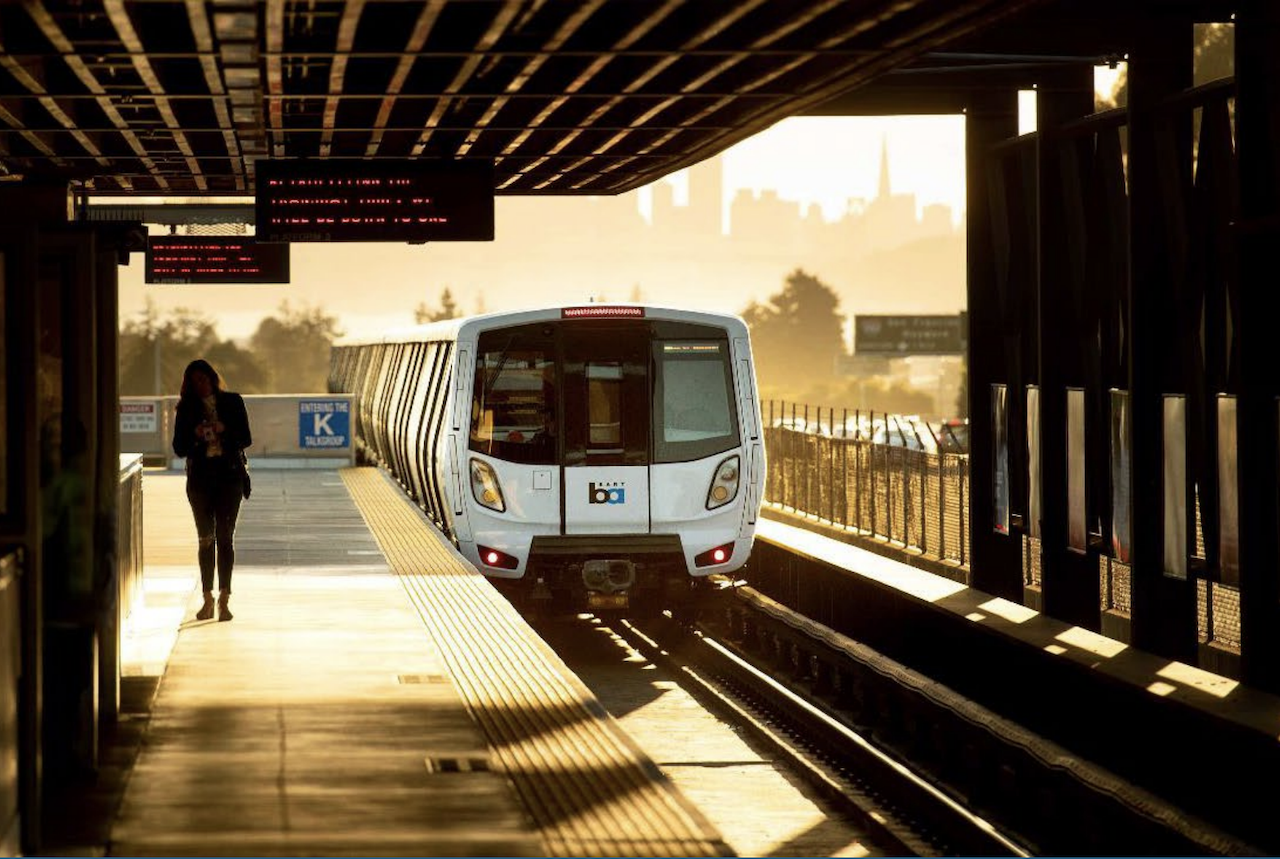
Bay Area Rapid Transit (BART) announces the end of paper ticket sales, beginning Sept. 30. Also, wireless service will soon be available for all Toronto Transit Commission (TTC) riders; Valley Transportation Authority’s (VTA) Mobility Assistance Program (MAP) has successfully been implemented; Atlanta BeltLine, Inc. starts planning study for balance of transit on the BeltLine Corridor; and CLEARSY supplies the platform screen gate monitoring system for Honolulu Area Rapid Transit (HART).
BART
Beginning Saturday, Sept. 30, BART will no longer sell magstripe paper tickets at SFO, the transit agency announced on Sept. 11. Only Clipper cards will be available at SFO vending machines and riders will continue to be encouraged to add Clipper card to their phone for a card-free option.
This change, the agency says, is occurring as BART begins to roll out new state-of-the-art fare gates, which will not accept paper tickets and as Clipper prepares for the launch of the next generation of Clipper.
BART began offering paper tickets at SFO in October 2022 in response to global supply chain issues impacting the region’s plastic card inventory. BART says it now has an adequate supply of cards and will eliminate the sale of all paper tickets. This includes the sale of red tickets at the Customer Service window at Lake Merritt Station for RTC applicants waiting for their Clipper card to arrive and paper tickets for group sales.
While BART will eliminate the sale of all paper tickets, riders are still able to use the paper tickets they already have on hand, including weekend promotion tickets, to enter and exit through most fare gates until Nov. 30.
Paper tickets balances cannot be transferred onto a Clipper card. BART offers paper ticket refunds for tickets with a remaining value greater than $1.00.
TTC
Minister of Innovation, Science and Industry François-Philippe Champagne on Sept. 1 announced new spectrum license conditions, which will require carriers to provide all passengers on Toronto’s subway system with access to cellular connectivity no later than Oct. 3.
The new license conditions are effective immediately and require all mobile carriers currently operating in Toronto to:
- Provide equal-quality services to all TTC subway riders by October 3, 2023.
- Quickly begin work to expand existing network coverage to provide full voice, text and data services throughout the TTC subway system within ambitious and specific timeframes.
- Provide service in all future stations and tunnels at the same time as they are made operational by the TTC.
Should mobile carriers fail to meet these conditions, the Minister, who made the announcement alongside Mayor of Toronto Olivia Chow and in the presence of several Toronto-area members of Parliament, will “take action as appropriate.” This could include imposing monetary penalties or suspending or revoking a carrier’s spectrum license.
“Canadians expect and deserve reliable telecommunications services—and in particular, access to emergency services when riding public transit. This is why the Government of Canada is taking action to require all carriers on Toronto’s subway system to provide access to cellular connectivity as soon as possible,” Minister Champagne said.
“Cellular connectivity on the subway is about more than just convenience. It is a critical public safety matter. TTC passengers have waited too long to access cellular services when riding the subway. That’s why today we’re taking immediate action on behalf of hundreds of thousands of frustrated passengers to require that by October 3, all subway riders have access to cellular services regardless of their mobile carrier,” said Minister Champagne.
“Everyone should be able to have cell phone service on the subway, regardless of their carrier. I welcome today’s announcement and invite mobile carriers to work together to quickly deliver the service that Torontonians need and deserve. People should be able to reliable on these services while riding the TTC,” said Chow.
VTA
VTA announced Sept. 11 that its Mobility Management services have successfully implemented the agency’s Mobility Assistance Program (MAP).
According to VTA, the program’s goal is to “provide reduced-cost and no-cost transportation options for seniors, individuals with disabilities and low-income persons seeking to find and retain employment and to support stable and healthy lives.”
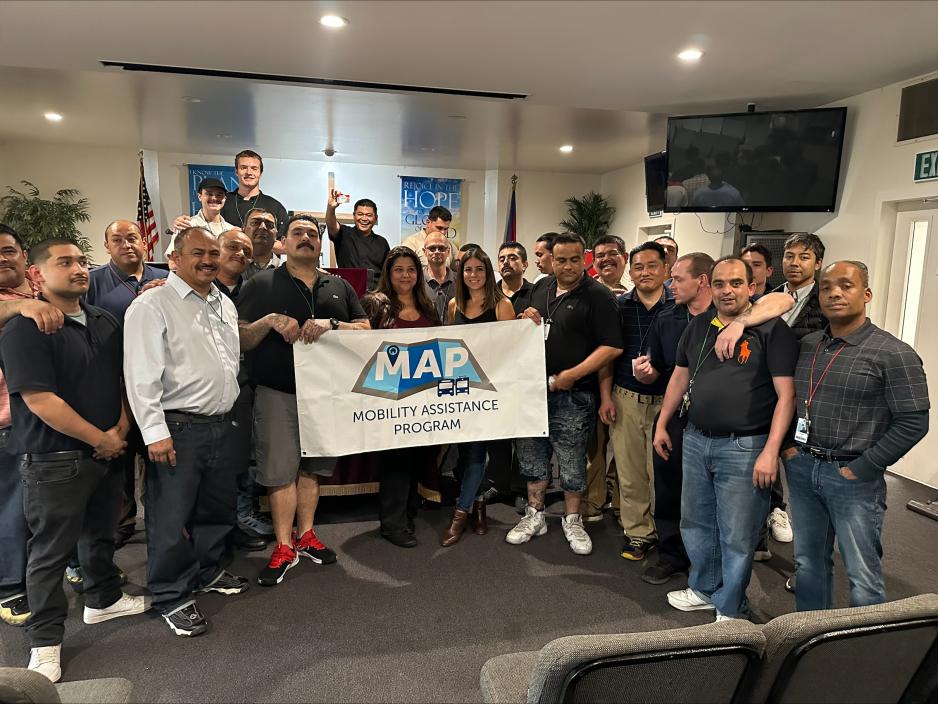
MAP is funded by MTC’s Lifeline Transportation Grant with the overall goal of advancing mobility and accessibility in Equity Priority Communities. During program development, extensive community outreach activities were conducted to identify transportation gaps, challenges, and solutions that the MAP program could address.
The community identified subsidized Transit and Paratransit Fares, Gas Pass Program, and one-call one-click as the most beneficial resources.
In August 2023, VTA launched the first phase of MAP in partnership with The Salvation Army. The initial phase of the program involves providing gas cards, VTA ACCESS Paratransit fares, and VTA monthly transit passes. In September 2023, another partnership was executed with Silicon Valley Independent Living Center.
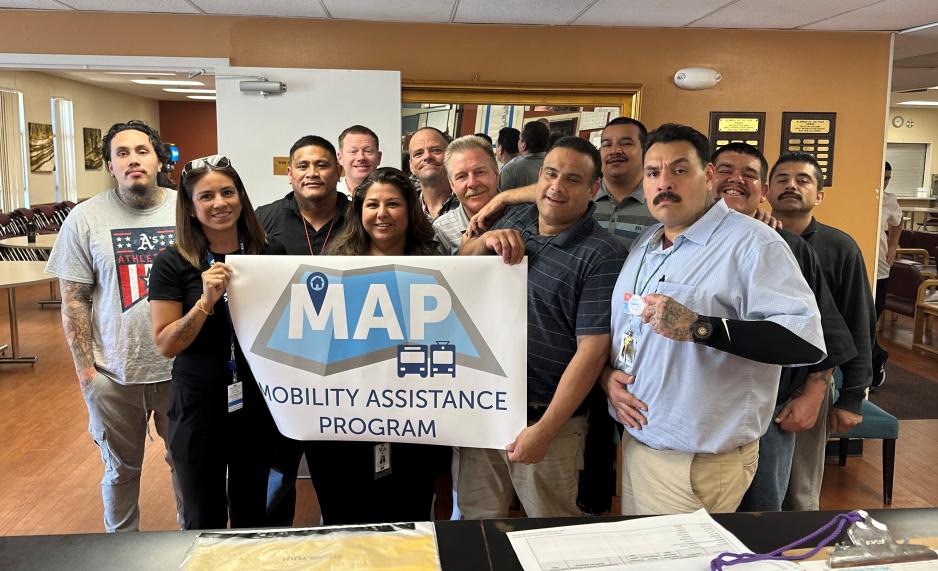
VTA is actively seeking additional Community-Based Organizations (CBOs), that serve Equity Priority Communities to conduct MAP’s administrative application process and to distribute gas cards, monthly VTA bus passes, and paratransit fares to eligible applicants.
BeltLine Corridor
Atlanta BeltLine, Inc. announced Sept. 11 that it is launching a transit planning study for a 13.6-mile portion for the rail corridor around the 22-mile BeltLine loop.
The study, funded by the Federal Transit Administration (FTA), will “identify the preferred Atlanta BeltLine transit alignment and station locations in the northwest quadrant” and will “solidify the preferred station locations in the southwest and southeast quadrants where the transit alignment has already been determined.” Metropolitan Atlanta Rapid Transit Authority (MARTA) has already completed a study that defines alignment in the northwest quadrant.
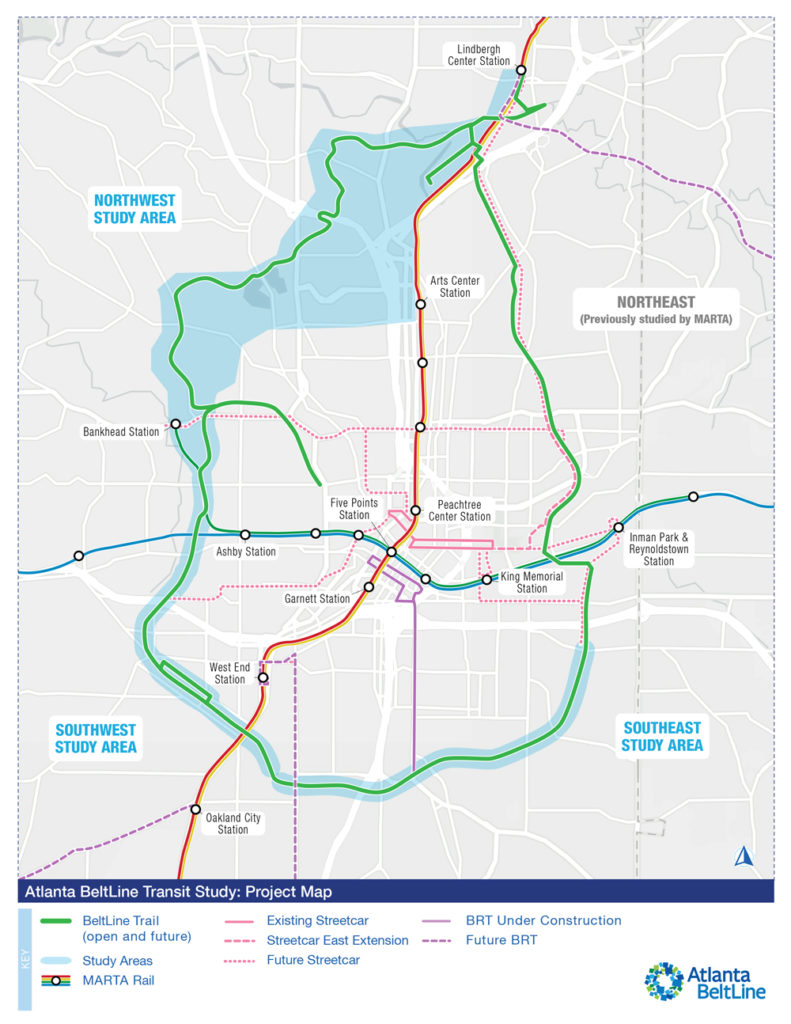
According to Atlanta BeltLine, Inc., rail transit in the BeltLine corridor will “complement and connect to MARTA’s existing heavy rail and bus networks and an extensive network of multi-use trails.” This, the urban redevelopment program says, will create “a more robust and equitable transportation system for Atlanta, making the BeltLine more accessible to people, regardless of weather, ability, or geography.”
The study builds upon previous reports, including the Atlanta BeltLine/Atlanta Streetcar System Plan (adopted by City Council in 2015), Record of Decision (published by FTA and MARTA in 2012), and MARTA’s study of BeltLine eastside corridor from Lindbergh to I-20 (completed in 2021).
Kimley-Horn & Associates will conduct the study, which will take 24 months from kick-off to final deliverables. Activities will include field investigation, consolidation of previous studies, stakeholder and public outreach, environmental screening, equity considerations, service planning, ridership forecasting, and financial planning. The project will specifically look at connectivity between the regional transit network and the regional trail network.
According to Atlanta BeltLine, Inc., light rail transit is essential in a layered infrastructure approach to address current and future mobility needs due to the influx of people anticipated to move to Atlanta in the next few decades. Between April 2022 and April 2023, 66,730 people moved to metro Atlanta, bringing the population to 5.16 million. The Atlanta Regional Commission forecasts the 21-county Atlanta region will potentially add 2.9 million people by 2050, reaching a total population of 8.6 million.
The planning area for the northwest segment of the Atlanta BeltLine transit corridor is from Lindbergh Center MARTA Station on the north side of the BeltLine loop to Bankhead MARTA Station on the western side. The study continues along the southwestern and southeastern quadrants of the BeltLine loop to Glenwood Avenue.
“Transit is at the heart of the BeltLine vision,” said Atlanta BeltLine, Inc. President and CEO Clyde Higgs. “The BeltLine is about high-quality ways to connect people to jobs, health care, shopping, education, and opportunity while making Atlanta a more mobile city. Rail transit is key to how we do that.”
A virtual public Citywide Conversation meeting will take place on Monday, September 25 at 6:30 p.m. The meeting will be broadcast virtually on Zoom and Facebook. The Zoom registration link is here. To join this meeting by phone, dial 929-205-6099 and enter webinar ID 857 7692 0273. Attendees will have the opportunity to ask questions via Zoom, telephone, and Facebook.
Meeting materials can be accessed on the day of the meeting here. All past presentations and Facebook Live recordings are available in the same online location.
More information about the BeltLine and transit is available here.
CLEARSY/HART
The Honolulu metro is equipped with STANLEY platform screen doors, which are controlled by the HITACHI Automatic Train Control (ATC) system, integrating STANLEY Train Door Control Units (DCU).
CLEARSY recently announced that it has developed a supervision, maintenance and operation system based on its DAME product, customized to meet the functional requirements of the HART end customer.
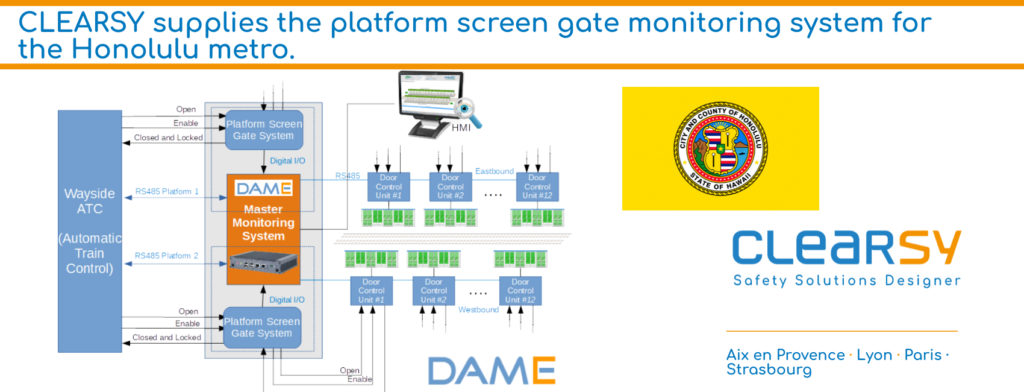
According to the software company, CLEARSY’s DAME is hosted on a small fanless PC running Linux, offering several functionalities, including:
- Supervision of platform doors thanks to an animated graphic interface that displays doors movements and the presence of the train on the platform in real time.
- Calculation and display of alarms using a logic equation engine.
- Real-time display of the status of each landing door in synchronization with the ATC, including all inputs and outputs.
- Parameter management for each DCU, with the option of downloading new software.
- Event history recorded in a logbook.
HMIs, according to CLEARSY, are animated via an Internet browser, accessible both locally and remotely.
The DAME also transmits information to ATC on the opening and closing status of platform doors, as well as any faults. It can also send commands to the DCUs when the train is at the platform.
The interfaces developed include:
- Implementation of the proprietary communication protocol with the HITACHI ATC.
- Implementation of the proprietary communication protocol with STANLEY DCUs.
- Input/output management via an interface card with 32 inputs and 32 outputs (opto-coupled).
This equipment, essential for managing a station’s platform doors, was deployed in each of the nine stations in the first section, between East Kapolei and Aloha Stadium, according to CLEARSY. Commissioning was successfully completed on June 20, 2023. To date, there are still 12 stations to be equipped, spread over three additional sections.
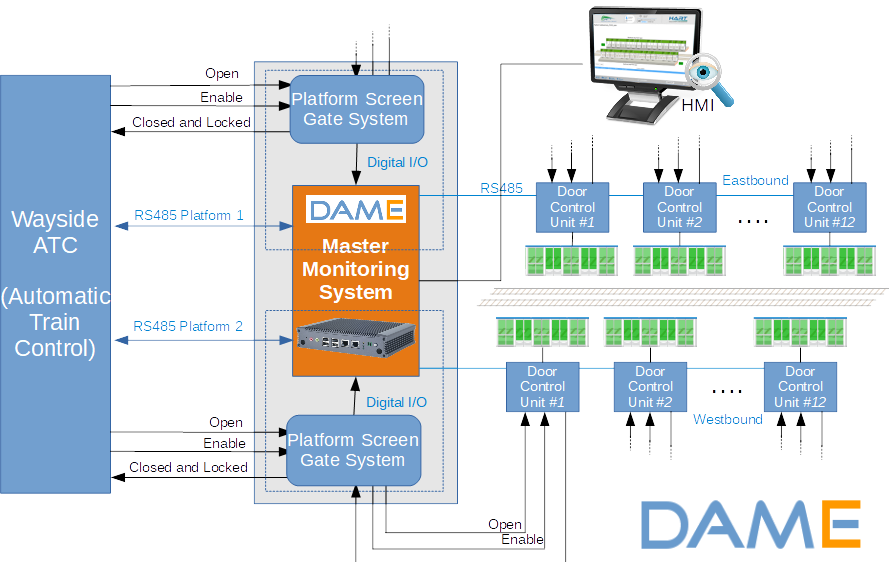
CLEARSY has also developed a separate integration tool for STANLEY landing doors. This tool, the company says, “enables the factory to check the correct operation of the wiring and the various functionalities before deploying the landing doors and their door control units in stations.” With this tool, CLEARSY says it “guarantees the quality and reliability of its landing doors from the moment they are manufactured, ensuring that they are fully operational before installation on site.”
“This proactive approach demonstrates CLEARSY’s commitment to providing robust solutions and ensuring customer satisfaction throughout the process, from production to commissioning,” according to the company.
“This achievement testifies to CLEARSY’s expertise in designing and implementing advanced technological solutions to meet the specific needs of its customers. By delivering a fully functional supervision system, CLEARSY has demonstrated its ability to provide tailor-made solutions that meet the high demands of the project and guarantee efficient management of the Honolulu metro’s platform doors,” the company added.



